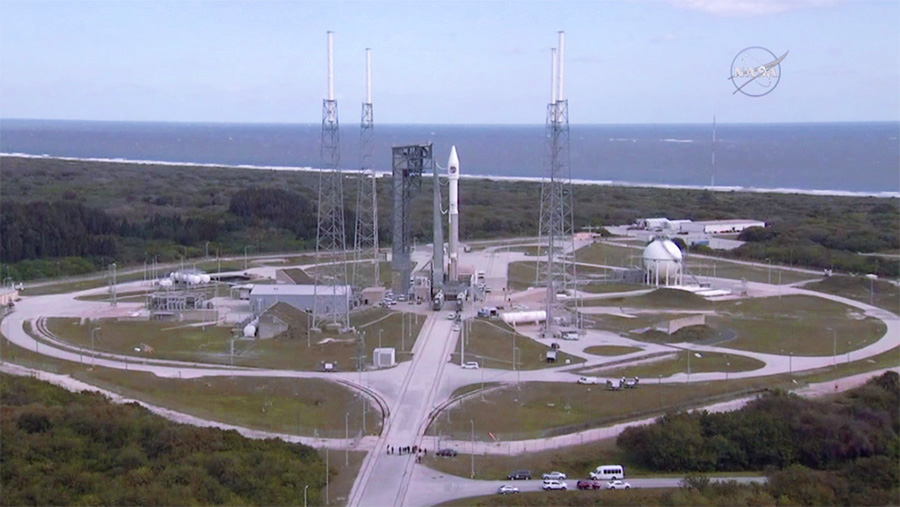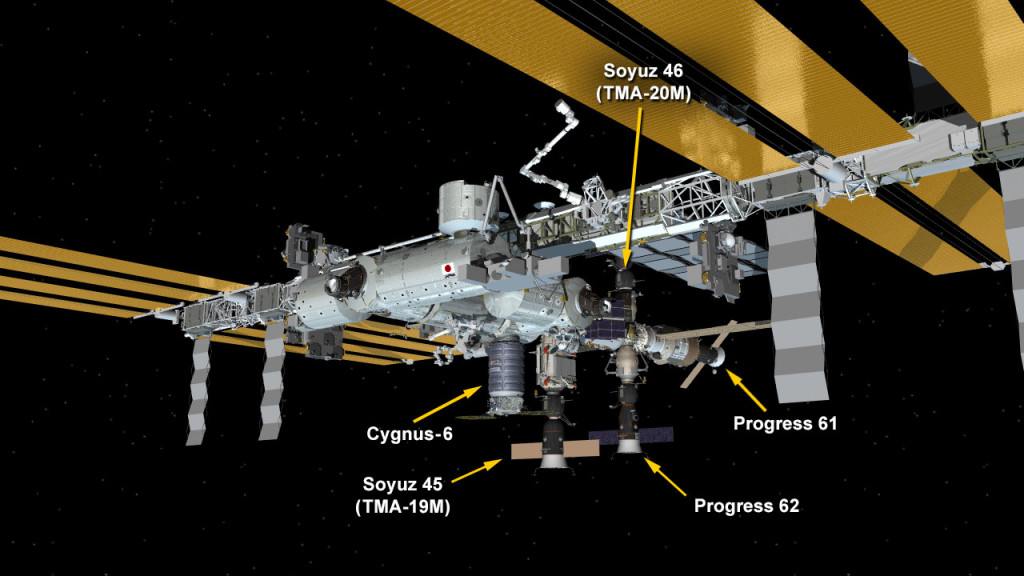 |
| Later, they're going to set that whole damn spacecraft on fire. Wait, what? (Image courtesy Jeff Williams / NASA.gov.) |
Last Tuesday, the Cygnus cargo craft launched from Cape Canaveral aboard a United Launch Systems Atlas 5 rocket. The Cygnus, which was built by the Orbital ATK company, held a large variety of scientific experiments, equipment, and other supplies.
 |
| Packed and ready to go: the Cygnus waits at Cape Canaveral. (Image courtesy NASA.gov.) |
The Cygnus made it to the station after a three-day transit through the atmosphere. After a successful launch of another Cygnus craft in December, this new and improved cargo craft was built to hold 25% more material - some 3.5 tons of supplies.
The scientific stash included a cache of nanosatellites, an experiment called Gecko Gripper that reenacts how the hairs on some small lizards' feet enable them to cling to walls, the Strata-1 experiment for assessing soil behavior on foreign planets, and the Meteor experiment, for determining chemical composition of meteors that enter the earth's atmosphere.
A very important combustion experiment also arrived on the Cygnus. The Saffire-1 experiment is unique, in that NASA intends for it to be a part of the largest intentional man-made fire in spacefaring history. Since fire is a great deal more unpredictable in microgravity than on Earth, its essential to understand its nature to help avoid what could be a devastating threat to astronauts in orbit. Eerie elements like invisible flames are just one part of what the experiment intends to study.
| "Spark that shit." -some space scientists. (Image courtesy NASA.gov.) |
When the Cygnus spacecraft returns to Earth in a few months, instead of burning up in the atmosphere like other cargo crafts, it will be remotely triggered to ignite a 1'-by-3' piece of cotton and fiberglass while still in low earth orbit. Cameras will observe the behavior of the combustion as it burns (literally) to the ground. Researchers are particularly concerned with learning if fires will continue to spread vertically (despite a lack of gravity), and also deducing what materials and fabrics are most affected by the blaze.
NASA project manager Gary Ruff extolled, “Saffire will be the biggest man-made fire ever in space...Currently, we can only conduct small combustion experiments in the microgravity environment of the space station. Saffire will allow us to safely burn larger samples of material without added risk to the station or its crew.”
But for now, the Cygnus is just chillin' at the station. Astronauts Tim Kopra and Tim Peake used the station's robotic grappler arm, Canadarm2, to snatch the Cygnus from the void of space and haul it home to the ISS. You can learn more specifics on the Cygnus's cargo and what purposes it will serve thanks to NASA's Tumblr, and follow its return adventures on Twitter via the hashtag #Cygnus.
 |
| The championship edition of the classic arcade claw game. The prize? A spaceship. (Image courtesy NASA.gov.) |
 |
| Nice catch! The Cygnus is snagged by the Canadarm2 and docked onto the ISS. (Image courtesy NASA.gov.) |
 |
| A solid parking job in orbit for the Cygnus spacecraft. (Image courtesy NASA.gov.) |
ESA astronaut Tim Peake has been adjusting to his orbital perch quite well, managing to capture some amazing imagery in between his scientific ministrations. He caught a modern-art-ish image of an iceberg...
 |
| "Granted - not the most exciting pic ever, but this iceberg drifting off Antarctica is about the size of London." -Britain's first ISS crewman, astronaut Tim Peake. (Image courtesy Tim Peake / ESA.) |
...and also managed to snag some stunning snaps over Patagonia.
 |
| Lake Viedma, being fed by the Viedma glacier, on the border of Chile and Argentina. Space teaches you not just science, but geography as well! (Image courtesy Tim Peake / ESA.) |
 |
| The Santa Cruz river, Argentina. (Image courtesy Tim Peake / ESA.) |
Congratulations to astronaut Peake, as well as astronaut Tim Kopra and cosmonaut Yuri Malenchenko, who all celebrated their hundredth day in space on Friday! You can check out even more of Peake's space-shots, here on his Flickr.
Want even more space? You can follow other recaps of station activity here.
That's all for this week, space fans! We'll see you next Sunday with news of even more awesomeness from orbit. Watch this space!
 |
| The Earth was just one big Easter egg this morning. We hope everyone had a lovely day, on-planet or off! (Image courtesy Jeff Williams / NASA.gov.) |

No comments:
Post a Comment